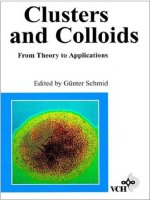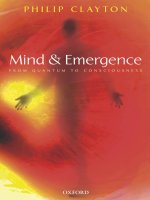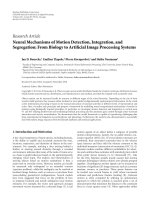clayton - mind and emergence - from quantum to consciousness (oxford, 2004)
Bạn đang xem bản rút gọn của tài liệu. Xem và tải ngay bản đầy đủ của tài liệu tại đây (3.1 MB, 249 trang )
Mind and Emergence
This page intentionally left blank
Mind and Emergence
From Quantum to Consciousness
PHILIP CLAYTON
1
1
Great Clarendon Street, Oxford OX2 6DP
Oxford University Press is a department of the University of Oxford.
It furthers the University’s objective of excellence in research, scholarship, and
education by publishing worldwide in
Oxford New York
Auckland Cape Town Dar es Salaam Hong Kong Karachi Kuala Lumpur Madrid
Melbourne Mexico City Nairobi New Delhi Taipei Toronto Shanghai
With offices in
Argentina Austria Brazil Chile Czech Republic France Greece Guatemala
Hungary Italy Japan South Korea Poland Portugal Singapore Switzerland
Thailand Turkey Ukraine Vietnam
Oxford is a registered trade mark of Oxford University Press
in the UK and in certain other countries
© Philip Clayton, 2004
First published 2004
All rights reserved. No part of this publication may be reproduced,
stored in a retrieval system, or transmitted, in any form or by any means,
without the prior permission in writing of Oxford University Press,
or as expressly permitted by law, or under terms agreed with the appropriate
reprographics rights organization. Enquiries concerning reproduction
outside the scope of the above should be sent to the Rights Department,
Oxford University Press, at the address above
You must not circulate this book in any other binding or cover
and you must impose this same condition on any acquirer
British Library Cataloguing in Publication Data
Data available
Library of Congress Cataloging-in-Publication Data
Clayton, Philip, 1956–
Mind and emergence : from quantum to consciousness/Philip Clayton.—1st ed.
p. cm.
Includes bibliographical references and index.
ISBN 0–19–927252–2 (hardcover : alk. paper)
1. Philosophical theology. 2. Philosophy of mind.
3. Consciousness—Religious aspects—Christianity.
4. Evolution—Religious aspects—Christianity. I. Title.
BT55.C53 2004
128´ .2—dc22 2004018735
ISBN 0–19–927252–2
13579108642
Typeset by Footnote Graphics Limited, Warminster, Wilts
Printed in Great Britain by Biddles Ltd., King’s Lynn
Preface
How humans construe the world and their place in it matters
deeply, even ultimately, to humans. Some of us are physicalists, hold-
ing that all things that exist are physical entities, composed out of,
and thus ultimately explainable in terms of, the laws, particles, and
energies of microphysics. Others are dualists because they believe
that at least humans, and perhaps other organisms as well, consist
both of these physical components and of a soul, self, or spirit that is
essentially non-physical. Emergence, I shall argue, represents a third
option in the debate and one that is preferable to both of its two
main competitors. Wherever on the continuum of options one falls,
one is likely to hold that position with great passion. What we
believe about ourselves and our place in the universe, about science
and history and the contents of our own consciousness, will make a
crucial difference to our understanding of ourselves and of the
world we inhabit.
A book on mind and emergence has the potential to unleash sus-
picion from both sides. Physicalists may close the cover when they
encounter the word ‘mind’, since they know that nothing like mind
exists in the physical world. Dualists’ reservations have exactly the
opposite motivation: mind or spirit could never emerge out of mat-
ter because the two are intrinsically different. No notion of mind
derived from matter could ever be adequate to what is meant by soul
or spirit or God. Hence, they conclude, one knows in advance that
emergence theories must fail.
I approach this project with the sense that each of these two views
omits a crucial part of the story. On the one hand, the physicalist
stance leaves out our experience as conscious agents in the world.
Not only do humans have the experience of thinking and willing and
deciding; we also continually experience the fact that these thoughts
and volitions actually do something—they are causally efficacious in
the world. When after some reflection I decided to rewrite the last
sentence, I consciously initiated a sequence of causes that led to
your experience of reading these words, of liking or disliking them,
vi Preface
and of reflecting on whether or not they are true. Dualism, on the
other hand, is undercut by the increasingly strong correlations that
neuroscientists are demonstrating between states of the central ner-
vous system and conscious states. The neural correlates of con-
sciousness do not prove that dualism is false, any more than they
prove that there will someday be a complete reduction of conscious-
ness to physiology. But successes in the neurosciences do suggest
that your consciousness is at least partially derived from a particular
biological system, your brain and central nervous system, in inter-
action with a set of physical, historical, and presumably also linguis-
tic and cultural factors.
Emergence is the view that new and unpredictable phenomena
are naturally produced by interactions in nature; that these new
structures, organisms, and ideas are not reducible to the sub-
systems on which they depend; and that the newly evolved realities
in turn exercise a causal influence on the parts out of which they
arose. The emergence thesis suggests that consciousness or what
we call mind is derived from and is dependent upon complex bio-
logical systems. But consciousness is not the only emergent level; in
one sense it is merely another in a very long series of steps that have
characterized the evolutionary process. It may be a particularly
interesting and complex level, including as it does the entire intel-
lectual, cultural, artistic, and religious life of humanity. Certainly,
for us as human agents, consciousness—both in its private, first-
person manifestations and in the others who make up our social
world—matters ultimately. But consciousness is not utterly unique;
conscious phenomena also manifest important analogies to emer-
gent realities at much earlier points in evolutionary history. In so far
as it recognizes that consciousness is in one sense ‘just another
emergent level’, emergence theory is not dualism in disguise.
Neither dualism nor reductive physicalism, then, tells the
complete story. Drawing the arguments from both philosophy and
contemporary science, I will defend the thesis that mind—causally
efficacious mental properties—emerges from the natural world, as
a further step in the evolutionary process. The naturalness of mind,
but also its differentia specifica, becomes evident only when one looks
closely at how biological evolution works and what it produces.
A book on the emergence of mind cannot shy away from the
question of the nature of emergent mind. After establishing a
position on the relation of human beings to the rest of evolutionary
history, a philosopher must then ask: what, more generally, is the
Preface vii
place of mind in the natural world? Can mind be fully understood
within the context of a naturalistic and scientific study of the world?
How might the emergence of mind be related to the question of
transcendent mind? Can one who takes seriously the methods and
results of the natural sciences make any sense of claims for the
influence of transcendent mind on the world? If one is to follow the
line of argument in the direction in which it naturally leads, one
must not be shy about extending the discussion into the domain
of religious beliefs. For those with interests in the philosophy of
religion or theology, the light that emergence sheds on religion may
represent its most crucial feature. Nonetheless, theologians and
other believers who appeal to the emergence concept should not do
so blithely, as the concluding chapter will show. The emergence
argument has a logic of its own, and it may require certain modifica-
tions to traditional versions of theism and to traditional theologies.
Even for those without religious beliefs, the application of emer-
gence to religion offers an intriguing thought experiment, one
which may increase or decrease one’s sense of the viability of this
notion for explaining more inner-worldly phenomena such as epi-
genetic forces or human mental experience.
The net result of this exploration of emergence, I trust, will be a
fuller understanding of the strengths of a concept that is receiving
much attention today, as well as of the criticisms to which it is
vulnerable. In the end, I hope to show, emergence offers a new and
more fruitful paradigm for interpreting a wide variety of phenom-
ena running from physics to consciousness, and perhaps beyond.
Bits and pieces of the developing argument have appeared in a
variety of publications over the half a dozen years that I have been
engaged in this research; full references are contained in the Bib-
liography. In particular, some portions of an earlier version of
Chapter 3 appeared in the volume, Science and Ultimate Reality:
Quantum Theory, Cosmology and Complexity, co-edited by John
Barrow, Paul Davies, and Charles Harper. Every segment of the
argument has however been reworked in the effort to construct a
single coherent argument concerning mind and emergence.
Any multi-year research project incurs an impressive variety of
debts. There may be conviction, and sometimes even truth, without
intersubjective testing and agreement. But without the community
of inquirers (and those who make it possible) there would be no
justified knowledge. I am grateful:
viii Preface
• to the John Templeton Foundation for a generous grant through
their first Research Grant Competition, which made possible a
much more intense examination of the science and philosophy of
emergence than I would otherwise have been able to achieve.
Parts of the text were completed during a Templeton-sponsored
programme known as the Stanford Emergence Project; I have
profited from the work with Stanford scientists and philosophers
and from those who flew in to participate in the various confer-
ences and consultations at Stanford.
• to the 123 scientists of the seven-year CTNS programme ‘Science
and the Spiritual Quest’, whose courage to explore religious and
spiritual questions without lowering the highest standards of
scientific enquiry was a model for this book and whose intel-
lectual efforts contributed to the conclusions reflected in these
pages;
• to Steven Knapp, provost of Johns Hopkins University, my major
intellectual collaborator on this project, as on many before it;
• to my research assistants during this period: Kevin Cody, Andrea
Zimmerman, Jheri Cravens, Dan Roberts, and Zach Simpson.
• and, finally, to the members of my family, who during these
particular years have paid a greater price than they should ever
have had to pay.
Contents
Preface v
List of Illustrations xi
1. From Reduction to Emergence 1
The rise and fall of reductionism 2
The concept of emergence 3
The pre-history of the emergence concept 7
Weak and strong emergence 9
Strong emergence: C. D. Broad 11
Emergent evolution: C. L. Morgan 13
Strong emergence since 1960 17
Weak emergence: Samuel Alexander 25
The challenge of weak emergence 31
Conclusion 32
Notes 33
2. Defining Emergence 38
Introduction 38
The problem of definitions 38
Five different meanings of emergence 40
An example: emergence at the fourth level 42
Doubts about emergence 44
Diverging approaches to the science and philosophy of
emergence 47
Downward causation 49
Emergence and physicalism 54
Conclusion: eight characteristics of emergence 60
Notes 62
3. Emergence in the Natural Sciences 65
Introduction 65
Physics to chemistry 66
Artificial systems 69
Biochemistry 73
x Contents
The transition to biology 78
Emergence in evolution 84
Toward an emergentist philosophy of biology 93
Conclusion 100
Notes 101
4. Emergence and Mind 107
The transition from biology 107
The three levels of emergence 108
Introducing the problem of consciousness 110
The neural correlates of consciousness 112
Can studies of neural correlates solve the problem of
consciousness? 117
Why consciousness remains the ‘hard problem’ 120
Weak supervenience and the emergence of mental
properties 124
Toward an emergentist theory of mind 128
Assumptions and a wager 139
The science and phenomenology of agent causation 140
Person-based explanations and the social sciences 144
Conclusion 148
Notes 149
5. Emergence and Transcendence 156
Introduction 156
Mind and metaphysics 157
Four metaphysical responses to the emergence of
mind 159
The presumption of naturalism 163
Is there an emergent level after mind? 165
The limits to possible scientific enquiry 169
What naturalistic explanations leave unexplained 172
Going beyond emergence 179
Trading mind–body dualism for theological dualism 185
Rethinking divine action 187
Integrating personhood and divine action 193
Closing objections 199
Conclusion 203
Notes 206
Bibliography 214
Index 231
List of Illustrations
3.1 Wolfram’s cellular automata 71
3.2 A sample autocatalytic process 74
3.3 The Belousov-Zhabotinsky reaction 75
3.4 Autocatalytic systems in nature 76
3.5 The slime mould cycle 77
3.6 Emergent behaviours in coleoptera larvae 79
3.7 Schematic summary of the plant-environment
cycle 81
3.8 Local-global interactions 82
3.9 Interactions in a typical complex ecosystem 83
3.10 Nested hierarchies in biological systems 84
4.1 The problem of supervenient mental causes 125
4.2 Neural representations of objects in the world 135
4.3 ‘Mind’ mirroring the sensory environment 136
This page intentionally left blank
1
From Reduction to Emergence
It is widely but falsely held that there are only two major ways
to interpret the world: in a physicalist or in a dualist fashion. The
mistaken belief in this dichotomy has its roots in the confrontation
of Newtonian physics with the metaphysical systems that still domi-
nated in the seventeenth century, which were built up out of Greek,
Christian, and medieval elements—but we will not worry here
about the historical backgrounds to the conflict. It is the thesis of
this book that the days of this forced dilemma are past.
The case stands on three legs. Two of these—the revolution in
metaphysics brought about by Kant, German Idealism, and process
thought; and the revolution in the theory of knowledge brought
about by non-objectivist epistemologies, contextualist philosophies
of science, and inherent limits on knowledge discovered within the
sciences themselves—I have explored in other publications and will
not reargue here.
1
The present argument against the physicalism-
dualism dichotomy is derived from a third source: the revolution
brought about by the sciences of evolution. The evolutionary pers-
pective has fatally undercut both sides of the once regnant either/or:
physicalism, with its tendency to stress the sufficiency of physics,
and dualism, with its tendency to pull mind out of the evolutionary
account altogether.
The evolutionary perspective which is realigning the long-
established philosophical frontiers is the core presupposition of the
most successful scientific explanation we have of biological phenom-
ena. More accurately, it is a component in all biological explanations
and a label for a large number of specific empirical results. Now to
say that biological evolution directly undercuts physicalism and dual-
ism would be a category mistake. Scientific theories have to be turned
into philosophical arguments before they can support or undercut
philosophical positions (except, of course, when philosophers make
direct errors about empirical facts or scientific theories, as not infre-
quently occurs). In the following pages I argue that emergence is the
philosophical position—more accurately, the philosophical elabora-
2 From Reduction to Emergence
tion of a series of scientific results—that best expresses the philo-
sophical import of evolutionary theory.
Thus we should say, if the argument turns out to be successful,
that it is emergence which undercuts the hegemony of the physicalist-
dualism dichotomy. There are now not two but three serious
ontological options. And, of the three, emergence is the naturalist
position most strongly supported by a synthetic scientific perspec-
tive—that is, by the study of natural history across the various levels
that it has produced—as well as by philosophical reflection.
the rise and fall of reductionism
The discussion of emergence makes no sense unless one conducts
it against the backdrop of reductionism. Emergence theories pre-
suppose that the project of explanatory reduction—explaining all
phenomena in the natural world in terms of the objects and laws
of physics—is finally impossible. For this reason, the overview of
emergence theories in the twentieth century needs to begin by
reviewing the difficulties that have come to burden the programme
of reductionism.
In its simple form, at least, the story of the rise and fall of reduc-
tionism is not difficult to tell (I return to the complexities in later
pages). Once upon a time there was a century dominated by the ideal
of reductionism. It was a century in which some of the deepest dreams
of science were fulfilled. Building on Newton’s laws, Maxwell’s equa-
tions and Einstein’s insights, scientists developed a body of theory
capable of handling the very small (quantum physics), the very fast
(special relativity, for speeds approaching c), and the very heavy (gen-
eral relativity, or what one might call gravitational dynamics). Chem-
istry was, for all intents and purposes, completed. Crick and Watson
discovered the structure of the biochemical information system that
codes for all biological reproduction and heritable mutations, and a
short while ago the mapping of the human genome was completed.
Breakthroughs in neuroscience promised the eventual explanation of
cognition in neurophysiological terms, and evolutionary psychology
brought evolutionary biology to bear on human behaviour. Each
success increased optimism that so-called bridge laws would eventu-
ally link together each of the sciences into a single system of law-
based explanation with physics as its foundation.
Yet, the story continues, these amazing successes were followed
by a series of blows to the reductionist program.
2
Scientists encoun-
From Reduction to Emergence 3
tered a number of apparently permanent restrictions on what
physics can explain, predict, or know: relativity theory introduced
the speed of light as the absolute limit for velocity, and thus as the
temporal limit for communication and causation in the universe
(no knowledge outside our ‘light cone’); Heisenberg’s uncertainty
principle placed mathematical limits on the knowability of both the
location and momentum of a subatomic particle; the Copenhagen
theorists came to the startling conclusion that quantum mechanical
indeterminacy was not merely a temporary epistemic problem but
reflected an inherent indeterminacy of the physical world itself;
so-called chaos theory showed that future states of complex systems
such as weather systems quickly become uncomputable because of
their sensitive dependence on initial conditions (a dependence so
sensitive that a finite knower could never predict the evolution of the
system—a staggering limitation when one notes what percentage of
natural systems exhibit chaotic behaviours); Kurt Gödel showed in a
well-known proof that mathematics cannot be complete . . . and the
list goes on.
In one sense, limitations to the program of reductionism, under-
stood as a philosophical position about science, do not affect every-
day scientific practice. To do science still means to try to explain
phenomena in terms of their constituent parts and underlying laws.
Thus, endorsing an emergentist philosophy of science is in most
cases consistent with business as usual in science. In another sense,
however, the reduction-versus-emergence debate does have deep
relevance for one’s understanding of scientific method and results,
as the following chapters will demonstrate. The ‘unity of science’
movement that dominated the middle of the twentieth century,
perhaps the classic expression of reductionist philosophy of
science, presupposed a radically different understanding of natural
science—its goals, epistemic status, relation to other areas of study,
and final fate—than is entailed by emergence theories of science.
Whether the scientist ascribes to the one position or the other will
inevitably have effects on how she pursues her science and how she
views her results.
the concept of emergence
In a classic definition el-Hani and Pereira identify four features gen-
erally associated with the concept of emergence:
4 From Reduction to Emergence
1. Ontological physicalism: All that exists in the space-time world are the
basic particles recognized by physics and their aggregates.
2. Property emergence: When aggregates of material particles attain an
appropriate level of organizational complexity, genuinely novel properties
emerge in these complex systems.
3. The irreducibility of the emergence: Emergent properties are irreducible to,
and unpredictable from, the lower-level phenomena from which they
emerge.
4. Downward causation: Higher-level entities causally affect their lower-
level constituents.
3
Each of these four theses requires elaboration; some require modifi-
cation. The defence of emergence in the following pages refers to
a set of claims no weaker than the four theses, but modified as
follows.
Concerning (1), ontological physicalism
The first condition is poorly formulated. It does correctly express the
anti-dualistic thrust of emergence theories. But the emergence the-
sis, if correct, undercuts the claim that physics is the fundamental
discipline from which all others are derived. Moreover, rather than
treating all objects that are not ‘recognized by physics’ as mere
aggregates, it suggests viewing them as emergent entities (in a
sense to be defined). Thus I suggest it is more accurate to begin with
the thesis of ontological monism:
(1Ј) Ontological monism: Reality is ultimately composed of
one basic kind of stuff. Yet the concepts of physics are
not sufficient to explain all the forms that this stuff takes—
all the ways it comes to be structured, individuated, and
causally efficacious. The one ‘stuff’ apparently takes forms
for which the explanations of physics, and thus the ontology
of physics (or ‘physicalism’ for short) are not adequate. We
should not assume that the entities postulated by physics
complete the inventory of what exists. Hence emergentists
should be monists but not physicalists.
Concerning (2), property emergence
The discovery of genuinely novel properties in nature is indeed a
major motivation for emergence. Tim O’Connor has provided a
sophisticated account of property emergence. For any emergent
property P of some object O, four conditions hold:
From Reduction to Emergence 5
(i) P supervenes on properties of the parts of O;
(ii) P is not had by any of the object’s parts;
(iii) P is distinct from any structural property of O;
(iv) P has direct (‘downward’) determinative influence on the pattern of
behaviour involving O’s parts.
4
Particular attention should be paid to O’Connor’s condition (ii),
which he calls the feature of non-structurality. It entails three
features: ‘The property’s being potentially had only by objects of
some complexity, not had by any of the object’s parts, [and] distinct
from any structural property of the object’ (p. 97).
Concerning (3), the irreducibility of emergence
To say that emergent properties are irreducible to lower-level
phenomena presupposes that reality is divided into a number of
distinct levels or orders. Wimsatt classically expresses the notion:
‘By level of organization, I will mean here compositional levels—
hierarchical divisions of stuff (paradigmatically but not necessarily
material stuff) organized by part-whole relations, in which wholes at
one level function as parts at the next (and at all higher) levels . . . ’
5
Wimsatt, who begins by contrasting an emergentist ontology
with Quine’s desert landscapes, insists that ‘it is possible to be a
reductionist and a holist too’ (p. 225). The reason is that emergentist
holism, in contrast to what we might call ‘New Age holism’, is a
controlled holism. It consists of two theses: that there are forms of
causality that are not reducible to physical causes (on which more
in a moment), and that causality should be our primary guide to
ontology. As Wimsatt writes, ‘Ontologically, one could take the
primary working matter of the world to be causal relationships,
which are connected to one another in a variety of ways—and
together make up patterns of causal networks’ (p. 220).
It follows that one of the major issues for emergence theory
will involve the question of when exactly one should speak of the
emergence of a new level within the natural order. Traditionally,
‘life’ and ‘mind’ have been taken to be genuine emergent levels
within the world—from which it follows that ‘mind’ cannot be
understood dualistically, à la Descartes. But perhaps there are mas-
sively more levels, perhaps innumerably more. In a recent book the
Yale biophysicist Harold Morowitz, for example, identifies no fewer
than twenty-eight distinct levels of emergence in natural history
from the big bang to the present.
6
6 From Reduction to Emergence
The comparison with mathematics helps to clarify what is meant
by emergent levels and why decisions about them are often messy.
Although mathematical knowledge increases, mathematics is clearly
an area in which one doesn’t encounter the emergence of some-
thing new. Work in mathematics involves discovering logical entail-
ments: regularities and principles that are built into axiomatic
systems from the outset. Thus it is always true that if you want to
know the number of numerals in a set of concurrent integers, you
subtract the value of the first from the value of the last and add one.
It is not as if that rule only begins to pertain when the numbers get
really big. By contrast, in the natural world the quantity of particles
or degree of complexity in a system does often make a difference. In
complex systems, the outcome is more than the sum of the parts.
The difficult task, both empirically and conceptually, is ascertaining
when and why the complexity is sufficient to produce the new
effects.
Concerning (4), downward causation
Many argue that downward causation is the most distinctive feature
of a fully emergentist position—and its greatest challenge. As
O’Connor notes, ‘an emergent’s causal influence is irreducible to
that of the micro-properties on which it supervenes: it bears its
influence in a direct, “downward” fashion in contrast to the opera-
tion of a simple structural macro-property, whose causal influence
occurs via the activity of the micro-properties that constitute it’.
7
Such a causal influence of an emergent structure or object on its
constituent parts would represent a type of causality that diverges
from the standard philosophical treatments of causality in modern
science. This concept of downward causation, which may be the
crux of the emergence theory debate, will occupy us further in
the coming chapters. Authors seeking to defend it often criticize the
strictures of modern ‘efficient’ causality and seek to expand
the understanding of causality, perhaps with reference to Aristotle’s
four distinct types of causal influence. The trouble is that material
causality—the way in which the matter of a thing causes it to be and
to act in a particular way—is no less ‘physicalist’ than efficient
causality, and final causality—the way in which the goal towards
which a thing strives influences its behaviour—is associated with
vitalist, dualist, and supernaturalist accounts of the world, accounts
that most emergentists would prefer to avoid. Formal causality—
the influence of the form, structure, or function of an object on its
From Reduction to Emergence 7
activities—is thus probably the most fruitful of these Aristotelian
options. Several authors have begun formulating a broader theory of
causal influence,
8
although much work remains to be done.
the pre-history of the emergence concept
It is widely conceded that George Henry Lewes first introduced the
term ‘emergence’.
9
Precursors to the concept can nonetheless be
traced back in the history of Western philosophy at least as far as
Aristotle. Aristotle’s biological research led him to posit a principle
of growth within organisms that was responsible for the qualities or
form that would later emerge. Aristotle called this principle the
entelechy, the internal principle of growth and perfection that directs
the organism to actualize the qualities that it contains in a merely
potential state. According to his doctrine of ‘potencies’, the adult
form of the human or animal emerges out of its youthful form.
(Unlike contemporary emergence theories, however, he held that
the complete form is already present in the organism from the
beginning, like a seed; it just needs to be transformed from its
potential state to its actual state.) As noted, Aristotle’s explanation of
emergence included ‘formal’ causes, which operate through the
form internal to the organism, and ‘final’ causes, which pull the
organism (so to speak) towards its final telos or ‘perfection’.
The influence of Aristotle on the Hellenistic, medieval, and early
modern periods cannot be overstated. His conception of change and
growth was formative for the development of Islamic thought and,
especially after being baptized at the hands of Thomas Aquinas, it
became foundational for Christian theology as well. In many
respects biology was still under the influence of something very
much like the Aristotelian paradigm when Darwin began his work.
A second precursor to emergence theory might be found in the
doctrine of emanation as first developed by Plotinus in the third
century
CE
10
and greatly extended by the Neoplatonic thinkers
who followed him. Plotinus defended the emergence of the entire
hierarchy of being out of the One through a process of emanation.
This expansion was balanced by a movement of finite things back
up the ladder of derivation to their ultimate source. The Neoplatonic
model allowed both for a downward movement of differentiation
and causality and an upward movement of increasing perfection,
diminishing distance from the Source, and (in principle) mystical
reunification with the One. Unlike static models of the world,
8 From Reduction to Emergence
emanation models allowed for a gradual process of becoming.
Although the Neoplatonic philosophers generally focused on the
downward emanation that gave rise to the intellectual, psychological
and physical spheres respectively (nous, psychê, and physika or kosmos
in Plotinus), their notion of emanation allowed for the emergence
of new species as well. In those cases where the emanation was
understood in a temporal sense, as with Plotinus, the emanation
doctrine provides an important antecedent to doctrines of biological
or universal evolution. Finally, process philosophies of the last 150
years are also important contributors to emergence theory
8
; they
will be dealt with further below.
When science was still natural philosophy, emergence played a
productive heuristic role. After about 1850, however, emergence
theories were several times imposed unscientifically as a meta-
physical
framework in a way that blocked empirical work. Key
examples include the neo-vitalists (e.g. H. Driesch’s theory of
entelechies) and neo-idealist theories of the interconnection of all
living things (e.g. Bradley’s theory of internal relations) around the
turn of the century, as well as the speculations of the British Emer-
gentists in the 1920s concerning the origin of mind (on whom more
in a moment).
Arguably, the philosopher who should count as the great modern
advocate of emergence theory is Hegel. In place of the notion of
static being or substance, Hegel offered a temporalized ontology, a
philosophy of universal becoming. The first triad in his system
moves from Being as the first postulation to Nothing, its negation. If
these two stand in blunt opposition, there can be no development
in reality. But the opposition between the two is overcome by the
category of Becoming. This triad is both the first step in the system
and an expression of its fundamental principle. Always, in the
universal flow of ‘Spirit coming to itself’, oppositions arise and are
overcome by a new level of emergence.
As an idealist, Hegel did not begin with the natural or the physical
world; he began with the world of ideas. At some point, ideas
gave rise to the natural world, and in Spirit the two are reintegrated.
The idealism of Hegel’s approach to emergent processes had to
be corrected if it was to be fruitful for science, though it would be
some eighty years before science began to play a major role in
understanding emergence. First it was necessary to find a more
materialist starting point, even if it was not yet one driven by the
natural sciences. Feuerbach’s ‘inversion’ of Hegel represented a
From Reduction to Emergence 9
start in this direction. For Feuerbach the laws of development were
still necessary and triadic (dialectical) in Hegel’s sense. But for the
author of The Essence of Christianity, the development of spiritual
ideas began with the human species in its physical and social reality
(‘species-being’). Karl Marx made the inversion more complete by
anchoring the dialectic in the means of production. Now economic
history, the study of the development of economic structures,
became the fundamental level and ideas were reduced to a ‘super-
structure’, representing the ideological after-effects or ex-post-facto
justifications of economic structures.
The birth of sociology (or, more generally, social science) in the
nineteenth century is closely tied to this development. Auguste
Comte, the so-called father of sociology, provided his own ladder
of evolution. But now science crowned the hierarchy, being the
rightful heir to the Age of Religion and the Age of Philosophy. The
work of Comte and his followers (especially Durkheim), with their
insistence that higher-order human ideas arise out of simpler
antecedents, helped establish an emergentist understanding of
human society. Henceforth studies of the human person would
have to begin not with the realm of ideas or Platonic forms but with
the elementary processes of the physical and social worlds.
weak and strong emergence
Although the particular labels and formulations vary widely,
commentators are widely agreed that twentieth-century emergence
theories fall into two broad categories. These are best described as
‘weak’ and ‘strong’ emergence—with the emphatic insistence that
these adjectives refer to the degree of emergence and do not
prejudge the argumentative quality of the two positions.
11
Strong
emergentists maintain that evolution in the cosmos produces new,
ontologically distinct levels, which are characterized by their own
distinct laws or regularities and causal forces. By contrast, weak
emergentists insist that, as new patterns emerge, the fundamental
causal processes remain those of physics. As emergentists, these
thinkers believe that it may be essential to scientific success to
explain causal processes using emergent categories such as protein
synthesis, hunger, kin selection, or the desire to be loved. But,
although such emergent structures may essentially constrain the
behaviour of lower-level structures, they should not be viewed as
active causal influences in their own right.
10 From Reduction to Emergence
Weak emergentists grant that different sorts of causal interac-
tions seem to dominate ‘higher’ levels of reality. They agree with
strong emergentists, for example, that evolution forms structures
which, as emergent wholes, constrain the motions of their parts.
But our inability to recognize in these emerging patterns new
manifestations of the same fundamental causal processes is due
primarily to our ignorance. For this reason weak emergence is
sometimes called ‘epistemological emergence’, in contrast to
strong or ‘ontological’ emergence. Michael Silberstein and John
McGreever nicely define the contrast between these two terms:
A property of an object or system is epistemologically emergent if the
property is reducible to or determined by the intrinsic properties of the
ultimate constituents of the object or system, while at the same time it is
very difficult for us to explain, predict or derive the property on the basis of
the ultimate constituents. Epistemologically emergent properties are novel
only at a level of description. . . . Ontologically emergent features are
neither reducible to nor determined by more basic features. Ontologically
emergent features are features of systems or wholes that possess causal
capacities not reducible to any of the intrinsic causal capacities of the parts
nor to any of the (reducible) relations between the parts.
12
It is not difficult to provide a formal definition of emergence in the
weak sense: ‘F is an emergent property of S if (a) there is a law to the
effect that all systems with this micro-structure have F; but (b) F can-
not, even in theory, be deduced from the most complete knowledge
of the basic properties of the components C
1
, . . . , C
n
’ of the system.
13
Both weak and strong emergence represent a conceptual break
with the reductive physicalist positions to which they are respond-
ing. The differences between them are significant and shall concern
us more in due course. Weak emergence, because it places a
stronger stress on the continuities between physics and subsequent
levels, stands closer to the ‘unity of science’ perspective. It has won a
number of important advocates in the sciences and in philosophy
from the end of the heyday of British Emergentism in the early
1930s until the closing decades of the century. But a number of
philosophers have recently disputed its claim to represent a genuine
alternative to physicalism. If the charge proves true, as I think it
does, weak emergence will leave us saddled with the same old
dichotomy between physicalism and dualism, despite its best efforts
to the contrary.
The contrasts between weak and strong theories of emergence—
both the issues that motivate them and the arguments they
From Reduction to Emergence 11
employ—are important. Yet their common opposition to reductive
physicalism is a sign of significant common ground between the
two positions. Before we enter into a no-holds-barred contest
between them, it is crucial to explore their shared history and the
numerous lines of connection between them. By attempting a
conceptual reconstruction of the history of emergentism in the
twentieth century, we will win a clearer picture of the similarities
and the oppositions between the two related schools of thought.
First the combined resources of the two schools must be marshalled
in order to make a decisive case against the metaphysics of physical-
ism; only then can we turn to the issues that continue to divide
them.
strong emergence: c. d. broad
I begin with perhaps the best known work in the field, C. D. Broad’s
The Mind and its Place in Nature. Broad’s position is clearly not
dualist; he insists that emergence theory is compatible with a
fundamental monism about the physical world. He contrasts this
emergentist monism with what he calls ‘Mechanism’ and with weak
emergence:
On the emergent theory we have to reconcile ourselves to much less unity
in the external world and a much less intimate connexion between the
various sciences. At best the external world and the various sciences that
deal with it will form a kind of hierarchy. We might, if we liked, keep the
view that there is only one fundamental kind of stuff. But we should have to
recognise aggregates of various orders.
14
Emergence, Broad argues, can be expressed in terms of laws
(‘trans-ordinal laws’) that link the emergent characteristics with the
lower-level parts and the structure or patterns that occur at the
emergent level. But emergent laws do not meet the deducibility
requirements of, for example, Hempel’s ‘covering law’ model;
15
they are not metaphysically necessary. Moreover, they have another
strange feature: ‘the only peculiarity of [an emergent law] is that we
must wait till we meet with an actual instance of an object of the
higher order before we can discover such a law; and . . . we cannot
possibly deduce it beforehand from any combination of laws which
we have discovered by observing aggregates of a lower order’ (p. 79).
These comments alone would not be sufficient to mark Broad as
a strong rather than weak emergentist. Nor do his comments on
12 From Reduction to Emergence
biology do so. He accepts teleology in nature, but defines it in a weak
enough sense that no automatic inference to a cosmic Designer is
possible. Broad also attacks the theory of entelechies (p. 86) and
what he calls ‘Substantial Vitalism’, by which he clearly means the
work of Hans Driesch. Broad rejects biological mechanism because
‘organisms are not machines but are systems whose characteristic
behaviour is emergent and not mechanistically explicable’ (p. 92).
He thus accepts ‘Emergent Vitalism’, while insisting that this
watered down version of Vitalism is an implication of emergence
and not its motivation: ‘What must be assumed is not a special
tendency of matter to fall into the kind of arrangement which has
vital characteristics, but a general tendency for complexes of one
order to combine with each other under suitable conditions to form
complexes of the next order’ (p. 93). Emergentism is consistent with
theism but does not entail it (p. 94).
It is in Broad’s extended treatment of the mind–body problem
that one sees most clearly why the stages of emergence leading to
mind actually entail the strong interpretation. Mental events, he
argues, represent another distinct emergent level. But they cannot
be explained in terms of their interrelations alone. Some sort of
‘Central Theory’ is required, that is, a theory that postulates a mental
‘Centre’ that unifies the various mental events as ‘mind’ (pp. 584ff.).
Indeed, just as Broad had earlier argued that the notion of a material
event requires the notion of material substance, so now he argues
that the idea of mental events requires the notion of mental
substance (pp. 598ff.). Broad remains an emergentist in so far as
the ‘enduring whole’, which he calls ‘mind’ or ‘mental particle’,
‘is analogous, not to a body, but to a material particle’ (p. 600).
(Dualists, by contrast, would proceed from the postulation of mental
substance to the definition of individual mental events.) The
resulting strong emergentist position lies between dualism and weak
emergence. Broad derives his concept of substance from events of a
particular type (in this case, mental events), rather than presup-
posing it as ultimate. Yet he underscores the emergent reality of each
unique level by speaking of actual objects or specific emergent
substances (with their own specific causal powers) at that level.
Broad concludes his magnum opus by presenting seventeen
metaphysical positions concerning the place of mind in nature
and boiling them down ultimately to his preference for ‘emergent
materialism’ over the other options. It is a materialism, however, far
removed from most, if not all, of the materialist and physicalist









